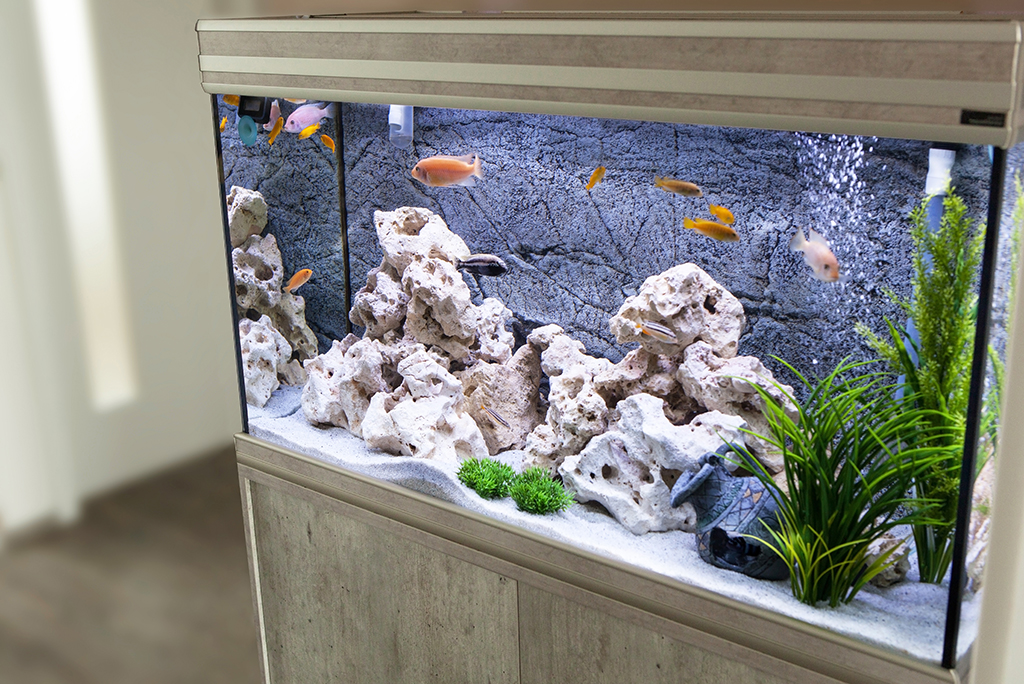Choosing the right aquarium size
There are several ways to determine the correct aquarium size for your needs.
Placement of the aquarium for the room or desired location should be in balance with the room. Before we consider gallons/liters of water, think about the aquarium as a function of the room, how will it look in the space. If you are placing an aquarium in your living room between say the sitting area and entertainment section or TV, how much space do you have? If the open area is 48 inches (122cm) than a 15-gallon (60 Liter) aquarium, 12” (30cm) wide and 24” (60cm) long, may be too small. An aquarium should make a statement in the room and balance with the room. You would not hang a very small picture on a very large wall any more than you would hang a very large picture on a small wall. Balance the size of the aquarium to the space, much like you would balance a piece of furniture to the room.
The stand that the aquarium will sit on is very important. First it needs to be sturdy to hold the weight of the aquarium. Remember a gallon of freshwater weighs 8.34 pounds (3.785 kilograms). And the aquarium stand is always best appreciated when it matches or blends with the style of the room.

An important consideration when selecting an aquarium is what type of fish you are going to keep. Consider how large the fish you desire to keep will grow at their adult size. You need to know how much room the fish you select needs to thrive and grow to select an aquarium size that is ideal. If you are unsure of the type of fish you want, you can always select the fish based on the size of the aquarium you have or purchase. As an example, goldfish in the store are often very small (~1” (2.5cm)) but these goldfish can grow fast and reach 12” (30cm). Adult goldfish need a larger aquarium than many tropical fish. So, you can see why selecting fish based on what size they are at the store is a concern. Always prepare for how large the fish will be as an adult. Another example is looking at a cherry barb, they will be small in the store and even as an adult their length only reaches 2” (5cm) and they will stay peaceful in a community aquarium. A fish that is commonly seen at aquatic stores are oscars. At the store oscars are normally small and 2” (5cm) in length is not uncommon. Oscars grow very fast and can reach 12” to 15” (~35cm). Oscars need a large aquarium and as an adult they are not good aquarium mates with smaller fish. Knowing the needs of the fish before purchase is critical to keeping a successful aquarium.
Choosing an aquarium that is longer and wider rather than taller and narrower should always be considered. Fish swim and live based on the footprint for exercise, resting, and territory. They swim mostly side-to-side rather than top-to-bottom. It is also the surface of the water that allows for gas exchange, removal of carbon dioxide and uptake of oxygen. Fish need oxygen to breathe. The larger water surface area the better ratio for toxic gases to escape and be exchanged for oxygen. Providing enough space for fish to swim and a large air to water surface ratio is important for healthy fish. The dimensions of the aquarium directly affect both. A very tall narrow aquarium can work but provides the least benefit for the fish. A bigger footprint provides more space for the fish and makes it easier to decorate or aquascape. Whenever possible choosing an aquarium with a wider footprint and thus greater surface area is better and accommodates a larger number of fish overall.
Consider that when selecting any aquarium, bigger is always better. The bigger the volume of water you keep the more fish you can ultimately have. Many fish species are best kept in multiples and do better in groups rather than as a solidary specimen. Fish that normally swim in a group or school together do not do well when only one or two are placed in an aquarium. When you place one or two of the schooling fish species into an aquarium they will often hide. However, when you place a greater number of schooling fish species into an aquarium they relax and are more apt to swim freely together through the aquarium. The bigger the volume of water you keep the more stable your water conditions will be. Any fish waste and/or overfeeding will be less of a concern in a larger aquarium than a smaller aquarium. The simple rule is “the solution to pollution is dilution”.
People often ask or state that a fish will only grow to the size of their aquarium. This is a false statement, an old myth. In fact, if fish are not given space to grow and swim, they may survive but they will often be stunted or deformed. To have your fish thrive they need room to grow and exercise/swim to maintain their health, color, and vigor. Depending on the fish species you are keeping some fish desire to maintain a territory or given space within the aquarium of their own. Some fish as they grow will become very territorial. Proper planning ahead of time yields the best results. If you select an aquarium that is too small than problems such as stunted or deformed fish, territorial fighting or unstable water conditions can result. So, you can see why bigger is better for the fish to thrive!
Small aquariums or nano aquariums can be exciting. You must plan appropriately; you will also need to stay attentive to any changes in water quality and react quickly and get ready for frequent water changes. Of course, the benefit of a nano aquarium is that they will take up less space and fit mostly anywhere. There is no specific size that make an aquarium a nano aquarium. Most people will say that aquariums less than 10 gallons (40 Liters) are considered a nano aquarium. Just remember the smaller the aquarium the less buffer room for error, issues such temperature fluctuation happen faster, a little bit of fish waste can be a major concern, selection of fish choices is reduced. Small aquariums or nano aquariums are best left for the more experienced fishkeeper. However, if you do not have the space for a larger aquarium then a nano aquarium can be a practical solution but plan accordingly.
For the reasons already discussed, considerations in selecting the best size aquarium include available space and adult fish size and type. In general, you can see why a larger aquarium is better resulting in fewer problems. Pollutants accumulate slower in a larger aquarium, reducing the amount of maintenance and frequency of water changes. For a first aquarium the recommended size should be no smaller than 20 gallons (80 Liters) ideally larger. A 29-gallon or 30-gallon (~120 Liter) aquarium or larger is a great size for the first-time hobbyist. If stocked lightly with compatible fish it will provide room for the fish to grow and provide enough water volume to maintain healthy water quality and colorful, active fish.
Now it is time to determine what type and size aquarium and the fish you want to maintain. Whether you desire a freshwater planted aquarium, a goldfish aquarium, perhaps a marine reef aquarium, an African Cichlid aquarium or a general community aquarium prior planning is essential. Look at the types of fish that are of interest to you and compatible together. With a little research and help from your local aquatic store you can pick which fish meet your needs and how many of each type is appropriate. Start planning today for your aquatic success tomorrow!
